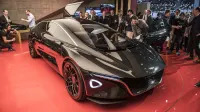Aston Martin lead designer doesn’t fear the future


Speaking at the global launch of the brand’s new Vantage — long its best-selling vehicle and the entry-level gateway into the Aston universe — Reichman is cautiously optimistic about the future of the traditional sports car. In part, because he believes that some humans will always crave speed and feel. “Washing clothes became automated, building refrigerators became automated. Everything becomes automated, because we see it as advanced,” Reichman says. “But there will always be a segment of the population that wants that experience. That engagement.”
Of course, as technology advances toward the alleged inevitability of our electric and autonomous future, and rules regarding who can own or drive what kind of car lead or follow, this segment may become increasingly restricted. Reichman lives in Oxford, England, which will become the first city in Europe to completely ban carbon-emitting vehicles in the start of the next decade, so he is well aware of these impending changes. “At the high performance end it might become the province of the rich, who will need private spaces to use these vehicles,” he says. “But what will happen with the Morgans or the Lotuses of the world — the more accessible brands? There may still be a place for them.”
This sense of possibility stems from Reichman’s belief that the next generation can hold simultaneously divergent ideas. “I think there is always going to be a space for the personal need and desire for performance driving. I see it even in kids today,” he says. “They believe in the world of electrification. That that is their inevitable future. But they still enjoy seeing an Aston Martin or a Ferrari, or a Lotus — if they ever see a Lotus …”
Reichman sees a bridging of this gap between our conventional views of the traditional and the futuristic in the current Aston product line. “The sports car remains a technological flagship. You could see this on our stand this year in Geneva. We had Valkyrie as well as Lagonda on the stand. These two cars represent the ultimate in technology advancing the naturally aspirated internal combustion, and the ultimate in technology advancing electrification and autonomy,” he says.
He sees these two developments working hand in hand, across brand and sub-brand. “You don’t have to be a scientist to know that Lagonda can inspire and influence Aston Martin. The same factory where that car will be built will also be where we make the new DBX crossover.”
Moreover, Reichman hopes to see these two streams align in the design and execution of the Aston product portfolio, especially within the category of “traditional” performance vehicles. “Sports cars haven’t yet taken advantage of the benefits of electrification. With batteries I’m surprised that there isn’t different forms. I think people haven’t been brave enough,” Reichman says.
“Would Tesla have been as successful if they had made an unearthly first product? I don’t think so. Because in that category people still expect something a bit familiar. But I think that Valkyrie will help. It’s a completely different form. Something experimental, and unnatural. Once designers start dictating form around batteries, imagine the forms that they will take. I’m very excited.”
Related Video:




